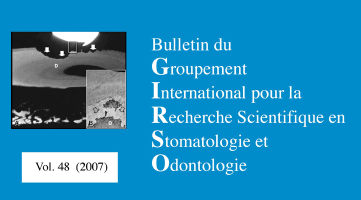“In vitro” comparative experimental study of antimicrobial action of mouth washing products
Abstract
Regular use of mouth rinses modifies the oral habitat, since bacterial populations are submitted to a high selective pressure during the treatment exercised by the active presence of the disinfectant. Mostly mouth rinses are based on the antibacterial effect of Chlorhexidine, Triclosan, essential oils and other antibacterials although other pharmaceutical characteristics can also affect their effectiveness. In this paper we compare “in vitro” the antibacterial effect of different oral rinsing solutions. Minimal Inhibitory Concentrations (MIC) and Minimal Bactericidal Concentrations (MBC) were determined as well as the kinetics of bacterial death in the presence of letal concentrations of the mouth rinses. MIC values expressed as Maximal Inhibitory Dilution (MID) of the mouth rinse ranged from 1 to 1/2048 depending on the microorganism and product, whereas Minimal Biocidal Concentration (MBC), expressed as Maximal Biocidal Dilution (MBD) ranged from 1 to 1/1024, being in general one dilution less than MIC. Maximal Biocidal Dilution is a good tool to measure the actual efficiency of mouth washing solutions. However, kinetics of death seems to be better in our work killing curves demonstrate that bacterial populations are mostly eliminated during the first minute after the contact of bacterial suspension and the mouth-washing solution. In all tested bacterial species mouth-washing solutions tested were able to reduce until suspension treated except 1 and 5.Downloads
Published
Issue
Section
License
I hereby certify that the authors of the above manuscript have all:
1. Conceived, planned, and performed the work leading to the report, or interpreted the evidence presented, or both;
2. Written the report or reviewed successive versions and shared in their revisions; and
3. Approved the final version.
Further, I certify that:
1. This work has not been published elsewhere and is not under revision in another journal;
2. Humane procedures have been followed in the treatment of experimental animals (if applicable);
3. Investigations in humans was done in accordance with the ethical standards of the responsible committee on human experimentation or with the Helsinki Declaration (if applicable).
4. This paper has been carefully read by a native English speaker who is familiar with the field of work (this applies to authors who are not fluent in English); and
5. The copyright of the article is transferred from the authors to the Bulletin du Groupement International pour la Recherche Scientifique en Stomatologie et Odontologie upon acceptance of the manuscript.



